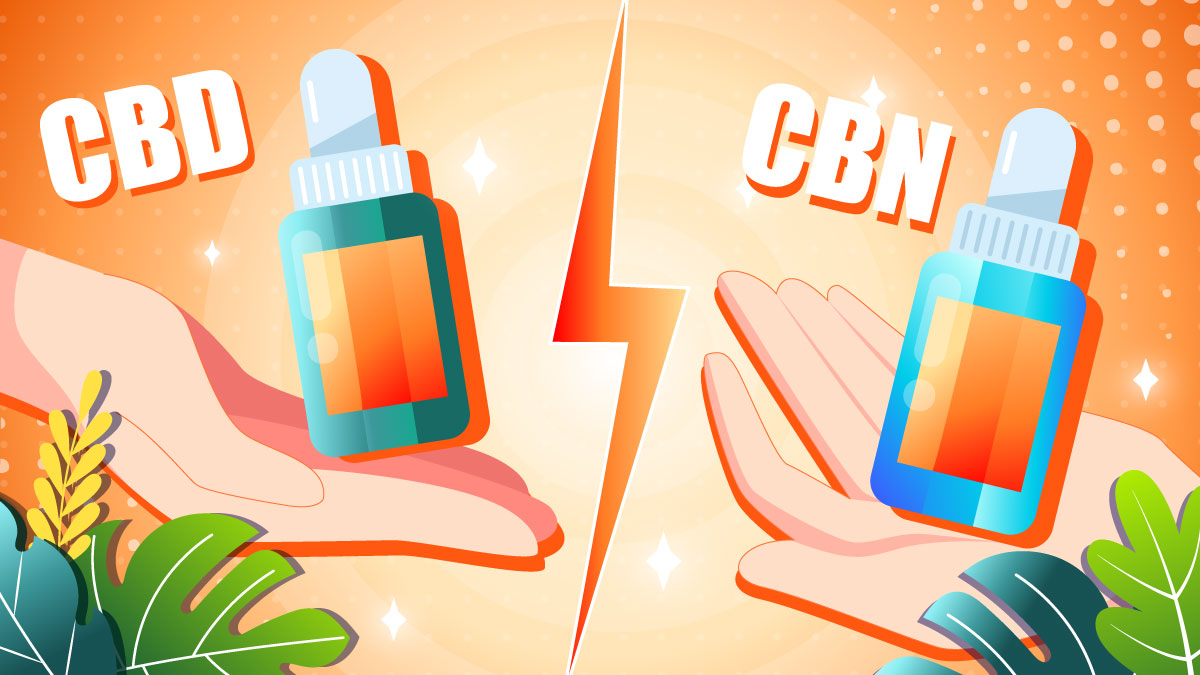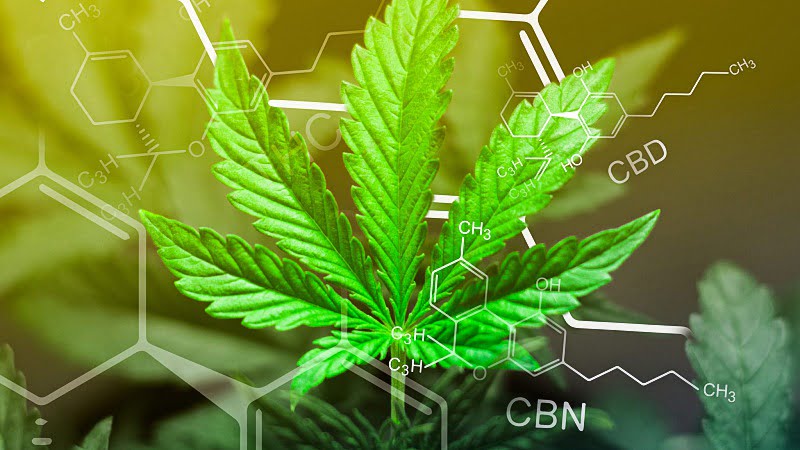Differences between CBD vs. CBN: What are the Benefits and Potential Side Effects

CBN is touted as the new cannabinoid with a promising therapeutic potential.
Pre-clinical results published by InMed show that CBN is more effective than both CBD and THC to relieve extreme pressure in the eye, otherwise known as glaucoma.
As a result, manufacturers are starting to produce new CBN-infused eyedrops for the treatment of glaucoma.
All this sudden talk about CBN might make you think it’s new, but it’s not. CBN has been around for a long time — often positioned as a component for sleep formulas.
Here, we’ll compare the similarities and differences between CBN and CBD — exploring differences in the dose, applications, and side effects of each cannabinoid.
Differences Between CBD & CBN
CBN stands for cannabinol and is considered a minor cannabinoid because it’s found only in trace amounts in cannabis plants. As a byproduct of oxidation, it’s located in old cannabis that’s been exposed to oxygen. In other words, CBN is found when THC ages and degrades over time.
CBD, also known as cannabidiol, is present in large amounts in cannabis plants and second only to THC — the prominent cannabinoid responsible for producing psychoactive effects.
Unlike THC, CBD is non-intoxicating and may also negate THC’s side effects, including anxiety and paranoia.
Both CBD and CBN exhibit similar molecular structures but their effects are different. Most manufacturers use decarboxylation (inducing heat to dry cannabis) or expose THC-rich strains to extreme UV light to force oxidation. It’s a process that mimics dry cannabis aging naturally.
The three cannabinoids — CBD, THC, and CBN — interact with the endocannabinoid system differently.
The ECS, or endocannabinoid system, consists of two receptors such as CB1 and CB2, that modulate several functions for our well-being. CB1 receptors are found primarily in the nervous system, brain, and surrounding areas. CB2 receptors are located in the tissues and cells related to the immune system.
Endocannabinoids produced by the body, as well as cannabinoids, bind to these receptors. For example, THC directly binds to CB1 receptors. Similarly, CBN binds to CB2 receptors.
CBD interacts with these receptors indirectly by activating enzymes responsible for stimulating the receptors.
Is CBN Stronger Than CBD?
CBN can be psychoactive if ingested in large doses. It’s slightly more psychoactive than CBD but very weak compared to THC, meaning it does not produce the same effects as THC.
It isn’t easy to source CBN, which is why it’s not available in abundance. But, overall, CBD is stronger than CBN if you consider its medicinal effects.
The British Journal of Pharmacology released a study in 2011 outlining the effects of CBN as a relaxant with the potential to relieve pain. It could also act as a neuroprotectant and appetite stimulant, according to some studies.
CBD vs. CBN: Legality
At the moment, CBN is legal since it complies with the 2018 Farm Bill. This bill made hemp legal on a federal level. So as long as it’s extracted from hemp, there should be no problem using it.
CBD and other products extracted from hemp containing less than 0.3% THC are considered federally legal.
Cannabis extracts that are not derived from hemp are still considered illegal federally. Legalizing marijuana on a federal level would clear the confusion surrounding marijuana-derived CBN products.
Usually, federal law is different from state laws when it comes to cannabis. States are free to interpret the laws in their own manner. Companies can sell CBN products because it’s not considered a Schedule I drug as long as the delta 9 THC content is below 0.3%.
CBD vs. CBN: Psychoactivity
Some studies suggest CBN doesn’t is non-intoxicating. The consensus is that CBN is about 10% as strong as THC.
Doses of 20–50 mg CBN are unlikely to produce any psychoactive effects. However, exceeding this amount may produce psychoactive effects similar to THC.
CBD is entirely non-psychoactive — which means no matter how much you take, you’re not going to feel high.
CBD vs. CBN Medical Benefits

Compared to CBD, CBN doesn’t have a lot of medical research to support its claims. This isn’t because CBN doesn’t have health benefits; it’s just that it’s not nearly as popular in academic circles as CBD has been in recent years. We expect to see a lot more research on this cannabinoid soon.
Recently, the journal of Psychopharmacology published a study where CBN was administered to rats. The rats displayed an increase in appetite. When they were given CBD, though, they revealed a decrease in appetite, suggesting that you could use both CBN and CBD to regulate appetite, depending on your preference.
CBN can help reduce sleep issues, especially insomnia. Scientists have suggested that it has the potential to be used as a sedative.
On the other hand, CBD can regulate our immune system. Like CBD, CBN can be used to relieve pain caused by issues such as arthritis.
Although CBN and CBD both have a lot to offer, they may work a lot better if combined rather than on their own.
The entourage effect supports this concept, suggesting that cannabinoids work in synergy to amplify their therapeutic potential. Most experts recommend using full-spectrum extracts to get the benefits of CBN and CBD together.
Why Is CBN So Expensive?
CBN is a lot more expensive than CBD.
Why?
The cannabis plant has many cannabinoids, out of which THC is the most abundant. The second cannabinoid present in large amounts is CBD. Both these cannabinoids can be extracted easily in high concentrations.
However, although CBN is a byproduct of THC, it’s not as abundant as THC or CBD, for that matter. It needs special extraction methods that become expensive for the manufacturers.
As a result, if you go for CBN isolates, it’s even more expensive and can be at least 4-10 times higher than CBD in some markets. The price is high mostly because of excess demand and very little supply.
As more manufacturers begin selling CBN, the prices will drop. Additionally, the price will vary from one manufacturer to another, so it’s best to check out a few sites and your local dispensaries to get a bigger picture.
Using CBD & CBN Together
Based on the entourage effect, a combination of CBN and CBD work better than isolates.
CBN may work as a sedative. Since CBD is also known to regulate sleep cycles, both cannabinoids could help with insomnia and other sleep-related issues.
Both cannabinoids uplift your mood and promote a sense of calm and balance naturally.
CBD vs. CBN Side Effects
CBD has no severe side effects even if you consume it frequently because it’s non-intoxicating. But, if you consume huge doses, you could experience dryness in your mouth and feel tired, along with a few bouts of diarrhea.
Similarly, CBN is non-psychoactive and has no side effects if you stick to your physician’s recommendation. However, if you take too much, you could experience fatigue and feel a bit more drowsy than usual.
The bottom line is that there’s no risk of using cannabinoids as long as you adhere to specific dosages. Talk to your doctor if you’re already taking other medications because you don’t want anything to interfere with your routine.
Summary: CBD vs. CBN
Both CBD and CBN have a lot to offer to improve our quality of life naturally. Their molecular structures are similar, but their effects are different. They also interact with the endocannabinoid system differently.
Although CBN is extracted from THC, it does not produce the same effects since it binds to the receptors weakly. It is slightly psychoactive but nowhere in the league of THC.
Many studies have been conducted on CBD, but the same can’t be said about CBN, which is why you should speak to your physician to address specific ailments.
As both cannabinoids have promising potential, it’s best to combine and use them frequently. Many companies now sell edibles, oils, and tinctures containing CBD and CBN, so it shouldn’t be too difficult to find them.
References
- Russo, E. B. (2011). Taming THC: potential cannabis synergy and phytocannabinoid‐terpenoid entourage effects. British journal of pharmacology, 163(7), 1344-1364. [1]
- Stone, N. L., Murphy, A. J., England, T. J., & O’Sullivan, S. E. (2020). A systematic review of minor phytocannabinoids with promising neuroprotective potential. British Journal of Pharmacology, 177(19), 4330-4352. [2]
- Rhee, M. H., Vogel, Z., Barg, J., Bayewitch, M., Levy, R., Hanuš, L., … & Mechoulam, R. (1997). Cannabinol derivatives: binding to cannabinoid receptors and inhibition of adenylyl cyclase. Journal of medicinal chemistry, 40(20), 3228-3233.
- Wong, H., & Cairns, B. E. (2019). Cannabidiol, cannabinol, and their combinations act as peripheral analgesics in a rat model of myofascial pain. Archives of oral biology, 104, 33-39.
- Farrimond, J. A., Whalley, B. J., & Williams, C. M. (2012). Cannabinol and cannabidiol exert opposing effects on rat feeding patterns. Psychopharmacology, 223(1), 117-129.